Thuringia: Difference between revisions
→Towns: new table Tag: nowiki added |
m →Cities: layout |
||
| Line 186: | Line 186: | ||
!Image |
!Image |
||
|- |
|- |
||
|align=center|1 |
|||
|1 |
|||
|[[Erfurt]] |
|[[Erfurt]] |
||
|independent |
|independent |
||
| Line 194: | Line 194: | ||
|[[File:Erfurt cathedral and severi church-2.jpg|200px|Erfurt: Cathedral and St. Severus' Church]] |
|[[File:Erfurt cathedral and severi church-2.jpg|200px|Erfurt: Cathedral and St. Severus' Church]] |
||
|- |
|- |
||
|align=center|2 |
|||
|2 |
|||
|[[Jena]] |
|[[Jena]] |
||
|independent |
|independent |
||
| Line 202: | Line 202: | ||
|[[File:Zentrum Jenas 2008-05-24.JPG|200px|Jena: City centre and Carl Zeiss' high-rises]] |
|[[File:Zentrum Jenas 2008-05-24.JPG|200px|Jena: City centre and Carl Zeiss' high-rises]] |
||
|- |
|- |
||
|align=center|3 |
|||
|3 |
|||
|[[Gera]] |
|[[Gera]] |
||
|independent |
|independent |
||
| Line 210: | Line 210: | ||
|[[File:Gera Untermhaus St. Marienkirche (2007).JPG|200px|Gera: Untermhaus district, St. Mary's Church and Weiße Elster river]] |
|[[File:Gera Untermhaus St. Marienkirche (2007).JPG|200px|Gera: Untermhaus district, St. Mary's Church and Weiße Elster river]] |
||
|- |
|- |
||
|align=center|4 |
|||
|4 |
|||
|[[Weimar]] |
|[[Weimar]] |
||
|independent |
|independent |
||
| Line 218: | Line 218: | ||
|[[File:Weimar - Blick zu Herderkirche & Stadtschloss.jpg|200px|Weimar: City centre]] |
|[[File:Weimar - Blick zu Herderkirche & Stadtschloss.jpg|200px|Weimar: City centre]] |
||
|- |
|- |
||
|align=center|5 |
|||
|5 |
|||
|[[Gotha]] |
|[[Gotha]] |
||
|[[Gotha (district)|Gotha]] |
|[[Gotha (district)|Gotha]] |
||
| Line 226: | Line 226: | ||
|[[File:Schloss Friedenstein Gotha 2.JPG|200px|Gotha: Friedenstein Castle]] |
|[[File:Schloss Friedenstein Gotha 2.JPG|200px|Gotha: Friedenstein Castle]] |
||
|- |
|- |
||
|align=center|6 |
|||
|6 |
|||
|[[Nordhausen]] |
|[[Nordhausen]] |
||
|[[Nordhausen (district)|Nordhausen]] |
|[[Nordhausen (district)|Nordhausen]] |
||
| Line 234: | Line 234: | ||
|[[File:Nordhausen - Blick übers Zentrum vom Petersbergturm .jpg|200px|Nordhausen: City centre]] |
|[[File:Nordhausen - Blick übers Zentrum vom Petersbergturm .jpg|200px|Nordhausen: City centre]] |
||
|- |
|- |
||
|align=center|7 |
|||
|7 |
|||
|[[Eisenach]] |
|[[Eisenach]] |
||
|independent |
|independent |
||
| Line 242: | Line 242: | ||
|[[File:Wartburg Eisenach DSCN3512.jpg|200px|Eisenach: Wartburg castle]] |
|[[File:Wartburg Eisenach DSCN3512.jpg|200px|Eisenach: Wartburg castle]] |
||
|- |
|- |
||
|align=center|8 |
|||
|8 |
|||
|[[Suhl]] |
|[[Suhl]] |
||
|independent |
|independent |
||
| Line 250: | Line 250: | ||
|[[File:Suhl0030.JPG|200px|Suhl: City centre]] |
|[[File:Suhl0030.JPG|200px|Suhl: City centre]] |
||
|- |
|- |
||
|align=center|9 |
|||
|9 |
|||
|[[Altenburg]] |
|[[Altenburg]] |
||
|[[Altenburger Land]] |
|[[Altenburger Land]] |
||
| Line 258: | Line 258: | ||
|[[File:ABGRoteSpBarthol.JPG|200px|Altenburg: City centre with the Red Spires]] |
|[[File:ABGRoteSpBarthol.JPG|200px|Altenburg: City centre with the Red Spires]] |
||
|- |
|- |
||
|align=center|10 |
|||
|10 |
|||
|[[Mühlhausen]] |
|[[Mühlhausen]] |
||
|[[Unstrut-Hainich-Kreis]] |
|[[Unstrut-Hainich-Kreis]] |
||
Revision as of 10:58, 19 November 2013
The Free State of Thuringia (Template:Lang-de, pronounced [ˈfʁaɪʃtaːt ˈtyːʁɪŋən]; English: /θəˈrɪndʒiə/) is a federal state of Germany, located in the central part of the country. It has an area of 16,171 square kilometres (6,244 sq mi) and 2.29 million inhabitants, making it the sixth smallest by area and the fifth smallest by population of Germany's sixteen states. Most of Thuringia is within the watershed of the Saale, a left tributary of the Elbe. Its capital is Erfurt.
Thuringia has been known by the nickname of "the green heart of Germany" (das grüne Herz Deutschlands) from the late 19th century,[1] due to the dense forest covering the land.
Thuringia is known in Germany for nature and winter sports. It is home to the Rennsteig, Germany's most famous hiking trail, and the winter resort of Oberhof. Germany has won more Winter Olympics gold medals than any other country in the last 20 years, and half of Germany's gold medals have been won by Thuringian athletes.[2]
Johann Sebastian Bach spent the first part of his life (1685-1717) and important further stages of his career in Thuringia. In the classical period, Goethe and Schiller lived at Weimar. Both worked also in the famous University of Jena nearby, which now hosts the most important centre of science in Thuringia. Other Universities of this federal state are the TU Ilmenau, the University of Erfurt, and the Bauhaus University of Weimar.
Etymology and symbols

The Name Thuringia or Thüringen derives from the Germanic tribe Thuringii, who emerged during the Migration Period. Their origin isn't completely known, an older theory said that they were sucessors of the Hermunduri, but the younger research rejected that. Other historians argue that the Thuringians were allies of the Huns, came to central Europe together with them and lived prior in what is Galicia today. Publius Flavius Vegetius Renatus first mentioned the Thuringii around 400; during that period, the Thuringii were famous for their excellent horses.
The Thuringian Realm existed until 531 and later, the Landgraviate of Thuringia was the largest state in the Region, persisting between 1131 and 1247. Afterwards there was no state named Thuringia anymore, nevertheless the terminus stayed common for the region between the Harz mountains in the north, the Weiße Elster river in the east, the Franconian Forest in the south and the Werra river in the west. Since the Treaty of Leipzig, Thuringia had its own dynasty again, the Ernestine Wettins. Their various lands formed the Free State of Thuringia, founded in 1920, together with some other small principalities. The Prussian territories around Erfurt, Mühlhausen and Nordhausen joined Thuringia in 1945.
The coat of arms of Thuringia shows the lion of the Ludowingian Landgraves from 12th century origin. Furthermore, there are eight stars around it, representing the eight former states, which formed Thuringia. The flag of Thuringia is a white-red bicolor, derived from the white and red stripes of the Ludowingian lion. The coat of arms and flag of Hesse are quite smilar to the Thuringian ones, because they are also derived from the Ludowingian symbols.
Symbols of Thuringia in popular culture are the Bratwurst and the Forest, because a large amount of the territory is forested.
History
Named after the Thuringii tribe who occupied it ca. AD 300, Thuringia came under Frankish domination in the 6th century.
Thuringia became a landgraviate in 1130. After the extinction of the reigning Ludowingian line of counts and landgraves in 1247 and the War of the Thuringian Succession (1247–1264), the western half became independent under the name of "Hesse", never to become a part of Thuringia again. Most of the remaining Thuringia came under the rule of the Wettin dynasty of the nearby Margraviate of Meissen, the nucleus of the later Electorate and Kingdom of Saxony. With the division of the house of Wettin in 1485, Thuringia went to the senior Ernestine branch of the family, which subsequently subdivided the area into a number of smaller states, according to the Saxon tradition of dividing inheritance amongst male heirs. These were the "Saxon duchies", consisting, among others, of the states of Saxe-Weimar, Saxe-Eisenach, Saxe-Jena, Saxe-Meiningen, Saxe-Altenburg, Saxe-Coburg, and Saxe-Gotha; Thuringia became merely a geographical concept.
Thuringia generally accepted the Protestant Reformation. The Catholic faith was abolished as early as 1520; priests that remained loyal were driven away and churches and monasteries were largely destroyed, especially during the German Peasants' War of 1525. In Mühlhausen and elsewhere, the Anabaptists found many adherents. Thomas Müntzer, a leader of some non-peaceful groups of this sect, was active in this city. Within the borders of Thuringia the Catholic faith was maintained only in the district called Eichsfeld, which was ruled by the Archbishop of Mainz, and to a small degree in the city and vicinity of Erfurt.

Some reordering of the Thuringian states occurred during the German Mediatisation from 1795–1814, and the territory was included within the Napoleonic Confederation of the Rhine organized in 1806. The 1815 Congress of Vienna confirmed these changes and the Thuringian states' inclusion in the German Confederation; the Kingdom of Prussia also acquired some Thuringian territory and administered it within the Province of Saxony. The Thuringian duchies which became part of the German Empire in 1871 during the Prussian-led unification of Germany were Saxe-Weimar-Eisenach, Saxe-Meiningen, Saxe-Altenburg, Saxe-Coburg-Gotha, Schwarzburg-Sondershausen, Schwarzburg-Rudolstadt and the two principalities of Reuss Elder Line and Reuss Younger Line. In 1920, after World War I, these small states merged into one state, called Thuringia; only Saxe-Coburg voted to join Bavaria instead. Weimar became the new capital of Thuringia. The coat of arms of this new state was simpler than they had been previously.
After briefly being controlled by the US, from July 1945, the state of Thuringia came under the Soviet occupation zone, and was expanded to include parts of Prussian Saxony, such as the areas around Erfurt, Mühlhausen, and Nordhausen. Erfurt became the new capital of Thuringia.
In 1952, the German Democratic Republic dissolved its states, and created districts ([Bezirke] Error: {{Lang}}: text has italic markup (help)) instead. The three districts that shared the territory of Thuringia were centered in Erfurt, Gera and Suhl.
The State of Thuringia was restored with slightly altered borders during Germany's reunification in 1990.
Geography
Topography
From the northwest going clockwise, Thuringia borders on the German states of Lower Saxony, Saxony-Anhalt, Saxony, Bavaria and Hesse.
The landscapes of Thuringia are quite diverse. The very north is occupied by the Harz mountains, followed by the Goldene Aue, a fertile floodplain around Nordhausen with the Helme as most important river. The north-west is taken in by the Eichsfeld, a hilly and sometimes forested region, where the Leine river emanates. The central and northern part of Thuringia is defined by the 3000 km² wide Thuringian Basin, a very fertile and flat area around Unstrut river and completely surrounded by the following hill chains (clockwise from the north-west): Dün, Hainleite, Windleite, Kyffhäuser, Hohe Schrecke, Schmücke, Finne, Ettersberg, Steigerwald, Thuringian Forest, Hörselberge and Hainich. Within the Basin the smaller hill chains Fahner Höhe and Heilinger Höhen are located. South of the Thuringian Basin, the Land's biggest mountain range is located, marked by the Thuringian Forest in the north-west, the Thuringian Highland in the middle and the Franconian Forest in the south-east. Most of this range is forested and the Großer Beerberg (983 m) is Thuringia's highest mountain. To the south-west, the Forest is followed up by the valley of Werra river, dividing it from the Rhön Mountains in the west and the Grabfeld plain in the south. Eastern Thuringia, commonly zoned as the area east of Saale and Loquitz valley, is marked by a hilly landscape, rising slowly from the flat north to the mountainous south. The Saale in the west and the Weiße Elster in the east are the two big rivers running from south to north and forming densely settled valleys in this area. Between them lies the flat and forested Holzland in the north, the flat and fertile Orlasenke in the middle and the Vogtland, a hilly but in most parts non-forested region in the south. The very eastern region (east of Weiße Elster) is the Osterland or Altenburger Land along Pleiße river, a flat, fertile and densely settled agricultural area.
The most important rivers in Thuringia are the Saale (a tributary of the Elbe) with its tributaries Unstrut, Ilm and Weiße Elster, draining the most parts of Thuringia and the Werra (the headwater of the Weser), draining the south-west and west of the Land. Furthermore, some small parts on the southern border are drained by tributaries of the Main (a tributary of the Rhine). There are no big natural lakes in Thuringia, but some of Germany's biggest dams including the Bleiloch Dam and the Hohenwarte Dam at Saale river same as the Leibis-Lichte Dam and the Goldisthal Pumped Storage Station within the Highland. Thuringia is Germany's only state without connection to navigable waterways.
The geographic center of the Federal Republic is located in Thuringia, within the municipality of Vogtei next to Mühlhausen. Thuringia's center is located only eight kilometres south of the capital's Cathedral within the municipality of Rockhausen.
Climate
Thuringia's climate is temperate with humid westerly winds predominate. Increasing from the north-west to the south-east the Land's climate shows continental features; winters can be cold for long periods, and summers can become warm. Dry periods are often recorded, especially within the Thuringian Basin, situated leeward to mountains in all directions. It is Germany's most dry area with annual precipitation of only 400 to 500 mm.
Within Thuringia are relatively big climate differences with a range from an average temperature of 8.5 °C and precipitation of 450 mm in Artern up to an average temperature of 4.4 °C and precipitation of 1300 mm at Schmücke station next to Oberhof within the Thuringian Forest.
| Climate data for Erfurt (1971-2000) | |||||||||||||
|---|---|---|---|---|---|---|---|---|---|---|---|---|---|
| Month | Jan | Feb | Mar | Apr | May | Jun | Jul | Aug | Sep | Oct | Nov | Dec | Year |
| Mean daily maximum °C (°F) | 2.2 (36.0) |
3.2 (37.8) |
7.8 (46.0) |
12.2 (54.0) |
17.5 (63.5) |
20.1 (68.2) |
22.5 (72.5) |
22.7 (72.9) |
18.3 (64.9) |
12.7 (54.9) |
6.4 (43.5) |
3.4 (38.1) |
12.4 (54.3) |
| Mean daily minimum °C (°F) | −3.1 (26.4) |
−2.9 (26.8) |
0.3 (32.5) |
2.8 (37.0) |
7.1 (44.8) |
10.2 (50.4) |
12.1 (53.8) |
12.0 (53.6) |
9.1 (48.4) |
5.1 (41.2) |
0.9 (33.6) |
−1.5 (29.3) |
4.3 (39.7) |
| Average precipitation mm (inches) | 24.7 (0.97) |
23.8 (0.94) |
35.5 (1.40) |
40.3 (1.59) |
54.8 (2.16) |
60.8 (2.39) |
62.5 (2.46) |
52.8 (2.08) |
40.5 (1.59) |
36.8 (1.45) |
37.5 (1.48) |
31.5 (1.24) |
501.5 (19.74) |
| Average precipitation days (≥ 1.0 mm) | 7.0 | 6.7 | 8.3 | 7.9 | 8.5 | 10.0 | 8.7 | 8.3 | 7.4 | 6.9 | 7.8 | 7.6 | 95.1 |
| Source: World Meteorological Organization[3] | |||||||||||||
Nature and environment
Due to many centuries of intensive settlement, most of the area is shaped by human influence. The potential natural vegetation of Thuringia is forest with beeches as predominant species, as it can be found for example in the Hainich mountains today. Within the higher regions, a mixture of beeches and spruces would be natural. Actually, most of the flat areas are cleared and in intensive agricultural use and most of the forests are planted with spruces and pines. Since 1990, the alteration of Thuringia's forests is in progress to get a more natural and tough vegetation to handle the climate change same as diseases and vermins. In comparison to the forest, the agriculture is still quite conventional yet and marked by large structures and monocultures. Problems here are caused especially by expanding dry periods during the summer months.
The environmental damages in Thuringia could be largely reduced after 1990. The condition of forests, rivers and air got improved by modernizing factories, houses (decline of coal heating) and cars and problem cases like the former Uranium surface mines around Ronneburg got remediated. Today's environmental problems are the salination of the Werra river, caused by discharges of K+S salt mines around Unterbreizbach and overfertilisation in agriculture, damaging the soil and the small rivers.
Environment and nature protection is from growing importance and attention since 1990. Large areas, especially within the forested mountains are protected as natural reserves, including Thuringia's first national park within the Hainich mountains, founded in 1997, the Rhön Biosphere Reserve, the Thuringian Forest Nature Park and the South Harz Nature Park.
Demographics
Cities
| Rank | City | District | Pop. 2012-12-31 | Change* | CoA | Image |
|---|---|---|---|---|---|---|
| 1 | Erfurt | independent | 203,485 | +0.68 | 
|

|
| 2 | Jena | independent | 106,915 | +0.47 | 
|
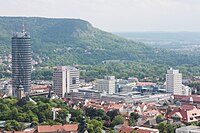
|
| 3 | Gera | independent | 95,384 | −0.55 | 
|

|
| 4 | Weimar | independent | 63,236 | +0.35 | 
|

|
| 5 | Gotha | Gotha | 44,371 | −0.05 | 
|
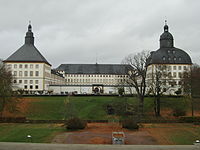
|
| 6 | Nordhausen | Nordhausen | 41,926 | −0.35 | 
|

|
| 7 | Eisenach | independent | 41,744 | −0.12 | 
|
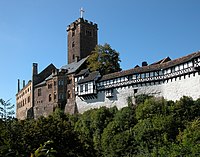
|
| 8 | Suhl | independent | 35,967 | −1.68 | 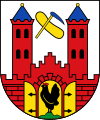
|
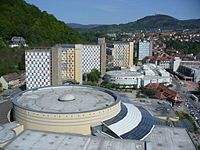
|
| 9 | Altenburg | Altenburger Land | 33,343 | −1.27 | 
|
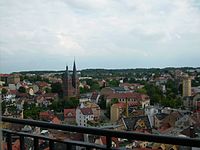
|
| 10 | Mühlhausen | Unstrut-Hainich-Kreis | 33,235 | −0.38 | 
|

|
* Average annual change in percent within the last three years (2009-12-31 until 2012-12-31), adjusted from incorporations and the 2011 Census results.
Religion
Since the Protestant Reformation, the largest religion in Thuringia has been Lutheranism. Under Communist rule, church membership was strongly discouraged and today over half of the population is religiously unaffiliated. As of 2009 the Evangelical Church in Germany remains the largest faith in the state, adhered to by 24.0% of the population. Members of the Catholic Church form 7.8%. 68.2% of the Thuringians are irreligious or adhere to other faiths.[4]
Politics
List of Minister-presidents of Thüringen
August 30, 2009 state election
Template:Thuringia state election, 2009
Turnout was 56.2%. SPD and CDU formed a coalition seven weeks after the election.[5]
Local government
Thuringia is divided into 17 districts (Landkreise):

Furthermore there are six urban districts (not numerated in the map):
Transportation
- Autobahn: A4, A9, A38, A71, A73;
- Airports: Altenburg-Nobitz Airport, Erfurt Airport.

References
- ^ A. Trinius (1898)
- ^ http://www.leg-thueringen.de/index.php?id=1982&L=1
- ^ "World Weather Information Service - Erfurt". World Meteorological Organization. Retrieved 22 January 2013.
- ^ Statistisches Jahrbuch Thüringen 2011 - PDF, 4,3 MB
- ^ CDU and SPD form Thuringia state coalition, The Local; 19 October 2009.
External links
- Official government site
- Tourist website for Thuringia Template:De icon
- Official Directory Template:De icon
- Another Tourist website for Thuringia
- Historical Overview
- Tourist website with many pictures of thuringian landscapes Template:De icon
- Alternative Tourist website for Thuringia Template:De icon Template:En icon
- Template:Dmoz
- Thuringian flags at
- "Thuringia (Germany)". Fotw.vexillum.com. Retrieved 2010-05-22.
- Marcus Schmöger. "Thüringen". Flaggenkunde.de. Retrieved 2010-05-22.
- Search engine for Thuringia with videos Template:De icon
 Geographic data related to Thuringia at OpenStreetMap
Geographic data related to Thuringia at OpenStreetMap


